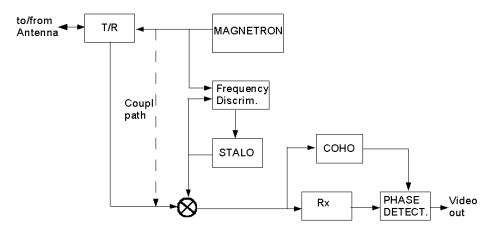COHERENT-ON-RECEIVE SYSTEMS
by Renato Croci
Just to give a brief overview of how the
problem of MTI was solved in the early years of Radars, when the only thing
they have to provide power at microwave frequencies was the magnetron...
BACK TO RADAR'S CORNER
In the early years of Radar, the only available microwave power device was
the Magnetron (yes, the same used in your microwave oven), which was not an
amplifier, but an high power oscillator: in pulsed applications- typical of
radar - RF energy is generated for the duration of the high-voltage pulse
applied at the cathode. But - as in any self-oscillating device - there is
no way to predict the phase of the microwave pulse so generated: the oscillation
starts, for each pulse, in an absolutely random way, unrelated from the phase
of the other pulses.
While this is not an issue in applications where only amplitude information
is of interest (e.g., ground mapping radars) it becomes a serious problem
in MTI applications. The typical
MTI scheme requires to keep memory of the phase of the transmitted pulse
deriving it from the two local oscillators.
How to solve this problem? The solution was found by reverting the approach:
instead of transmitting a signal derived from a reference of known phase,
the (random) phase of each transmitted pulse is memorised by the system and
corrected for in the receiver.
This approach is known as "coherent-on-receive" (as opposed to the "coherent-on-transmit"
scheme which uses an amplifier) and its classic implementation is depicted
below.

Here, the microwave local oscillator (LO1 in classic MTI scheme) is used for
the receiver only, and is generally referred to as "STALO" (STAble Local
Oscillator). Considering that the oscillation frequency of the magnetron
is not quite accurate nor stable, the frequency of the STALO is locked to
the magnetron frequency by means of an automatic frequency control circuit
(AFC) which uses a frequency discriminator, to ensure that their difference
provides the correct Intermediate Frequency.
The Tx pulse is coupled into the Rx chain, and at IF is used to phase-lock
the COHO (COHerent Oscillator) which is an oscillator, capable of being initialised
to the phase of the coupled pulse, and used as phase detector reference.
The two "classic" ways to implement a COHO are:
- delay line: the coupled IF signal is injected in a loop with a delay line
(often, a long cable) with delay equal to the pulse length. The output was
fed back to the delay line input (recovering the losses with an amplifier),
thus recirculating it for the whole duration of a PRI.
- locked oscillator: the oscillator loop gain was reduced below the unit
(stopping oscillation), then the oscillation conditions was restored while
the reference pulse was applied. In this way, the oscillation started with
the same phase of the reference pulse.
Another possible approach to coherency recovery makes use of a normal oscillator
as COHO. The phase of the Tx pulse is "memorised" by sampling the I and Q
components of the coupled pulse, and this information is used to adjust the
phase of the COHO signal sent to the phase detector via a phase shifter.
One big limitation of the coherent-on-receive technique is that the memory
of transmit phase last only the duration of a PRI. With a new transmit pulse,
starting at a random phase, the system locks on this new phase and memory
of the former one is lost. As a result, the phase of second-time-around echoes
at the output of the receiver remains totally random, preventing their cancellation
by MTI filters.
Therefore, MTI doesn't work for multiple-time-around echoes.
Another possible approach to use power-oscillator devices in MTI application
is to "prime" them: practically, as done for the COHO in the classic coherent-on-receive,
the oscillation of the magnetron (or whatever microwave power oscillator is
used) is initialised on the phase of a reference pulse injected in it while
it is turned up, allowing to implement a coherent-on-transmit system.
This anyway requires the capability to amplify microwave signals at medium
power (generally, in the order of some Watts) in order to achieve proper locking,
capability which wasn't available in the early times. And when it become
possible, also high-power amplifier tubes such as klystrons and, later, TWTs
started to be available, making all the above phase-locking techniques obsolete
for most applications.
BACK TO RADAR's CORNER
Last updated

